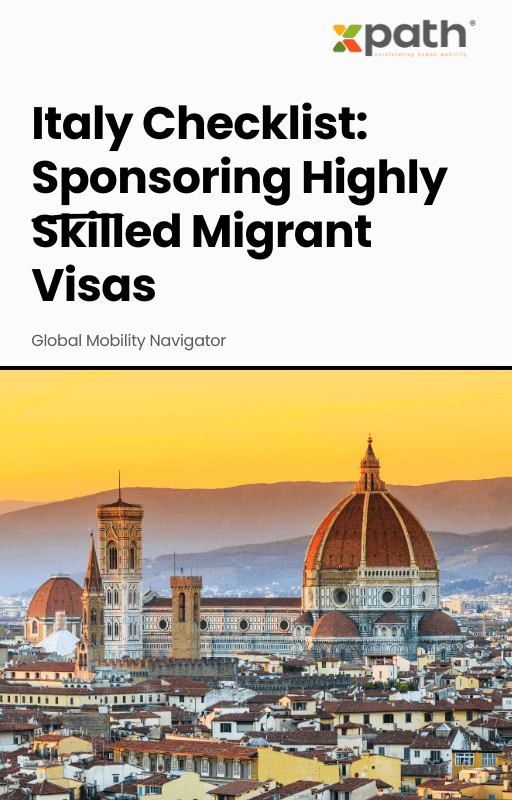Italy Checklist: Sponsoring Highly Skilled Migrant Visas
Grab a copy of a guide to international employee relocation
View E-bookAs companies expand their operations across borders, it becomes essential to have a comprehensive global mobility policy in place. Such a policy not only ensures a smooth transition for employees but also helps organizations effectively manage their international talent mobility and global workforce.
In this article, we will explore the key factors to consider when choosing your global mobility policy. From understanding the different types of policies to evaluating best practices, we will provide you with valuable insights to help you create a program that works for both your organization and your employees. Let’s dive in!
Before diving into the details, it’s important to have a clear understanding of the different types of global mobility policies. Each policy type caters to specific scenarios and comes with its own set of benefits and considerations. Here are some of the most common global mobility policy types:
These policies are designed for employees who are willing to relocate for a great job opportunity or an adventure. It can be disruptive and expensive, considering factors such as spouse or partner careers, children, and real estate. To ensure a successful move, employer support is imperative.
This policy type is suitable for employees who travel regularly between their home and host countries. It may involve back and forth travel or one-way travel with an extended stay in between. The employee maintains home country compensation and benefit plans.
Short-term assignments typically last between three months to one year. The intention is for the assignee to return to their home country at the end of the assignment. Assignees maintain home country compensation and benefit plans. This policy type is often used to reduce the cost of international relocation.
Long-term assignments can last anywhere from one to five years. The assignee is expected to return to their home country at the end of the assignment. Assignees maintain home country compensation and benefit plans. This policy type requires careful planning and support to ensure a successful assignment.
A permanent move involves an accompanied one-way transfer of indefinite length. The assignee immediately becomes a local employee in the destination location, and the company provides domestic home sale benefits at departure and home purchase benefits at the destination. The employee transitions to the local payroll, with compensation and benefits based on the labor laws and requirements of the destination country.
Localization occurs when a long-term assignment results in a permanent transfer to the host location. Benefits associated with the assignment end as of the localization date, or some benefits may be phased out over time. Assignees transition from home to host country compensation and benefits. Retirement plans and social security contributions in the departure country cease.
Now that we have a clear understanding of the different global mobility policy types, let’s explore the best practices that can help you design an effective policy.
When designing your global mobility policy, it’s crucial to consider the following best practices to ensure its success:
Your global mobility policy should align with your organization’s overall business objectives. Consider factors such as talent acquisition, retention, and global expansion strategies. By aligning your policy with your business goals, you can ensure that it supports your organization’s growth and success.
In today’s dynamic business environment, flexibility and adaptability are key. Your global mobility policy should be flexible enough to accommodate changing business needs and evolving employee expectations. Consider incorporating provisions that allow for adjustments based on individual circumstances and emerging industry trends.
Compliance with legal and regulatory requirements is of utmost importance when designing your global mobility policy. As you expand your operations globally, it’s essential to stay updated on local labor laws, tax regulations, and immigration requirements. Ensure that your policy adheres to all relevant legal and regulatory frameworks.
Clear and effective communication is essential when implementing a global mobility policy. Ensure that all stakeholders, including employees, managers, and HR teams, are well-informed about the policy’s provisions, eligibility criteria, and support mechanisms. Transparent communication fosters trust and ensures a smooth transition for employees.
To create a successful global mobility policy, it’s crucial to consider the needs and preferences of your employees. Conduct surveys, engage in conversations, and gather feedback to understand their expectations and concerns. By incorporating employee input into your policy design, you can create a program that resonates with their needs and aspirations.
Benchmarking against industry peers can provide valuable insights into global mobility policies and practices. Participate in surveys and studies conducted by reputable organizations to access benchmarking solutions. By understanding how your policy compares to others in the industry, you can identify areas for improvement and make informed decisions.
A global mobility policy is not a one-time endeavor. It requires ongoing evaluation and review to ensure its effectiveness. Regularly assess the policy’s impact, collect feedback from stakeholders, and identify areas that need improvement. By continuously refining your policy, you can adapt to changing business needs and evolving employee expectations.
Choosing the right global mobility policy is crucial for organizations expanding their operations across borders. By understanding the different policy types and considering best practices, you can create a program that aligns with your business objectives and meets the needs of your employees. Remember to stay flexible, transparent, and compliant with legal and regulatory requirements. With a well-designed global mobility policy in place, you can effectively manage international talent mobility and support your organization’s growth in the global marketplace.
If you need assistance in creating or enhancing your global mobility program with technology, the xpath.global team is here to help. Contact us today to explore how we can support your organization’s global workforce management needs.

Italy Checklist: Sponsoring Highly Skilled Migrant Visas
Grab a copy of a guide to international employee relocation
View E-book